When Peter Farrell qualified as a structural engineer in 2008, the climate for engineers in Ireland was very different to what it was when he enrolled in the course four year previously. Post-economic crash, to get a job as an engineer would have meant emigration. Instead, he chose to work in a different field, that of his parents' farm at Kilmessan, Co Meath.
At the time, his father David was milking 100 cows in a 10-unit parlour supplying milk all-year round to Glanbia. Cows calved for 10 months of the year and the workload was heavy with little time off. Year-round calving to supply liquid milk to the once lucrative Dublin market is the traditional type of dairy farming operated in The Pale – the counties surrounding the capital city.
After doing his Leaving Certificate in 2004, Peter decided to study engineering in university. So why is he farming now?
“I qualified as an engineer in 2008, right at the peak of the economic crash," says Peter. "I lost my first graduate job before I even started. The work I did manage to secure was in a windowless office, monotonous and a 90-minute commute from home. It seemed at the time that emigration was looking like the only option."
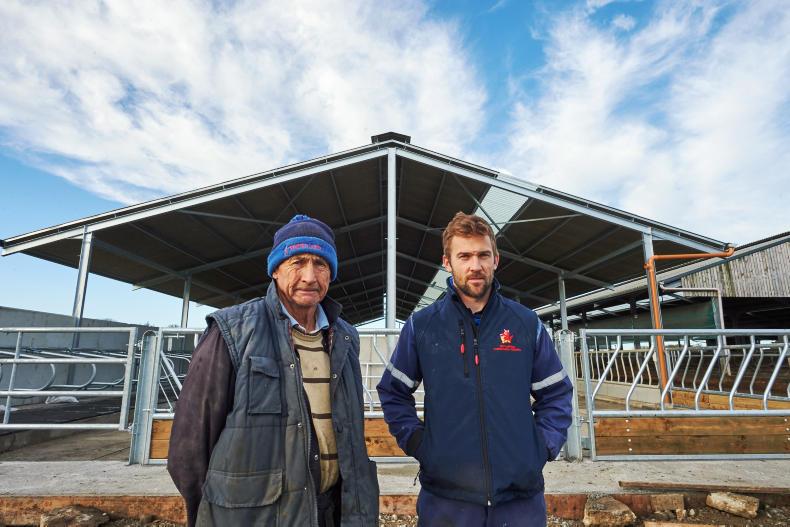
Peter qualified as an engineer in 2008 but to get a job in that field he would have had to emigrate, so he went to his parents' field instead. \ Barry CroninChanging fields
“Then one day I was helping my sister, who is an accountant, do the farm accounts for 2008 and when I saw what the farm was capable of turning over, it got me thinking about the opportunities that were on my doorstep. I suppose if I had seen the 2009 turnover I might have come to a different conclusion, but it was too late then,” Peter jokes.
When he was leaving school, farming wasn’t really on the horizon for him, but he knew it was always an option. For Peter and his peers at that time, working in Ireland’s booming construction sector was a bigger lure than working in the dairy industry, as quotas were going to shackle farmers for another 10 years.
I have seen too many good farms destroyed by being held on to too long by the father and the younger person doesn’t get a say or an opportunity to make changes
David says there was never any pressure on any of his children to return home to farm.
“I have seen too many good farms destroyed by being held on to too long by the father and the younger person doesn’t get a say or an opportunity to make changes. I always said that I would retire by 60 and if any of the children wanted it, they could take it on," says David.

"I have seen too many good farms destroyed by being held on to too long by the father and the younger person doesn’t get a say or an opportunity to make changes." \ Barry CroninJoint decisions
David has now passed 60 but is still heavily involved in the day-to-day operation. Strategic decisions are made jointly but are driven by Peter.
And substantial changes have been made. The Farrells have stopped calving cows in the autumn and moved to one spring-calving block. This was a big change for David, having been calving cows in the autumn since he started farming in 1950. He says year-round calving always put food on the table, but as Peter pointed out, there are now more mouths to feed.
Back in 2009, the Farrells were farming 72ha in total with 32ha in the milking block. They were milking 100 cows and rearing all progeny. The replacement heifers were calving at 30 months of age and the male calves were kept for bull beef.
In 2010, they started to focus more on breeding by using high EBI sires; they started measuring grass and financial budgeting. In 2011, they moved to calving the heifers at 24 months of age and moved to two 12-week breeding periods. This, along with quota restrictions, allowed a major cull of infertile and carry-over cows. They also leased a 24-hectare outfarm.
In 2012, they reduced the autumn calving period to six weeks, which was sufficient to fill the liquid milk contract for December and January and meant that this contract was not being diluted with extra litres. A new cubicle shed for 110 cows was built that year also, along with additional roadways and 18ha was reseeded.
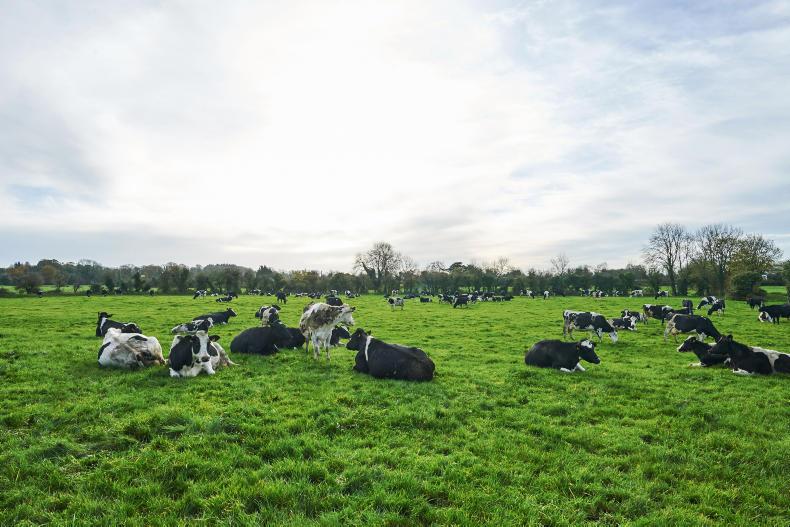
The Farrells have cut out autumn calving. \ Barry CroninIncreasing numbers
In 2013, cow numbers increased to 120 and 9ha was purchased on the milking platform. An additional 14ha was also reseeded that year. In 2014, cow numbers increased to 135. Extra milk quota was purchased and a new 24-unit milking parlour was built, along with extra slurry storage and a further 18ha was reseeded.
Since quotas went, more land has been leased and cow numbers have increased with 200 milked in 2016. An extra 33ha was leased at the beginning of 2017, bringing land on the milking platform to 100ha.
The lease for the new land was signed in February 2017. Originally, the Farrells had intended to milk 230 cows that year. But with the new land on stream, extra animals had to be purchased if the farm was to be stocked correctly, so they bought 54 calved heifers in March. Peak cow numbers milked in 2017 were 290.
No more autumn calving
While the number of cows being milked has trebled, the system they are being milked in has changed also, with autumn calving having ceased. The whole herd now calves in an 11-week period in spring.
Peter places a big emphasis on grass and this is paying off. Grass growth has averaged 16t/ha over the last three years, with 80% of the farm growing in excess of 16.5t/ha in 2016. This year, Peter reckons the farm will finish up having grown 17t/ha of grass.
He says the fertiliser bill is now bigger than the meal bill, with as much chemical nitrogen and phosphorus spread as is permitted, along with lime and potash where required. All of the owned land and most of the leased land is now at index 3 and 4, but a lot of the most recently acquired land has very low soil fertility.
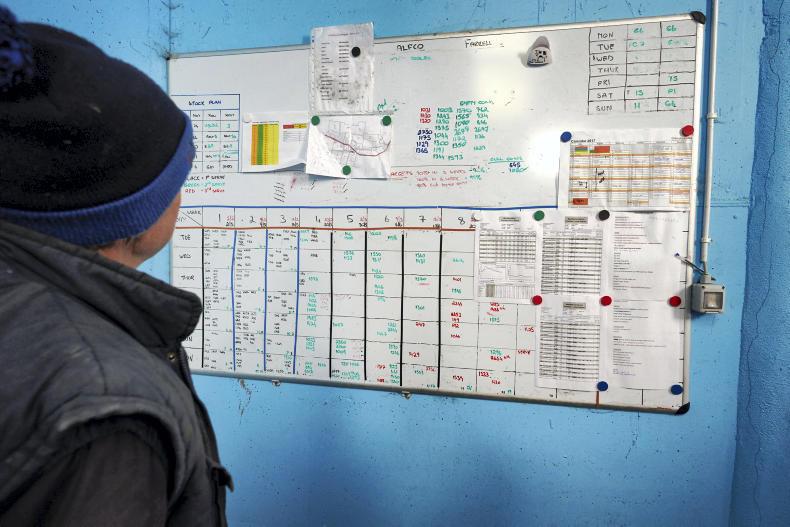
Good management is the key to profitability on this farm. \ Barry CroninSoil fertility
“The soil fertility on this block was on the floor, but because it was all in new grass this year, and because it was well fertilised, grass exploded all year,” Peter says.
Over half of the milking platform has been reseeded over the past two years so a very high proportion of the farm has good grass species. This is undoubtedly helping the farm to achieve such high grass growth rates. The farm grew over 4kg/day last winter.
But the farm is also well fertilised. Most of the milking block receives a maintenance fertiliser rate of four to five bags/acre of 18:6:12 spread over three applications. The silage fields and lower soil fertility fields are targeted most with slurry. So the maintenance is provided by chemical fertiliser and the build-up is provided by slurry.
Cow type
The Farrell herd is now a mix of various cow types. Some of the older, larger Holstein Friesian cows still persist; many of their offspring are also on the large side.
Over the last few years, the emphasis has been on using high-EBI Holstein Friesian sires on the cows. Last year, all the heifers calved down to Jersey and nearly all the cows were put in calf to Jersey.
“It’s not a big deal,” says Peter. “The first cross heifer is a super animal so for me it’s a no-brainer to use Jersey and as herd size grows we need an easier-care cow. I think our cows are an ideal cross for Jersey as they have plenty of milk from the liquid milk days.”
His plan is to have a herd of 75% Holstein Friesian cows and 25% Jersey cows, or an F12 J4 in genetic terms. To get this, he intends using a high-EBI Holstein Friesian bull on his 50:50 crossbred cows and a crossbred bull on these to maintain the ratio of breeds as much as possible.
Of the 54 bought-in heifers, 25 were Jersey crossbred, five were purebred Jersey (as a novelty) and the rest were high EBI. Peter says he tried to source more crossbreds but was unable to find the animals he wanted. Interestingly, he turned down buying some high-EBI crossbred heifers as he felt the average production from their herd would be too low, even at 450kg MS/cow, on average.
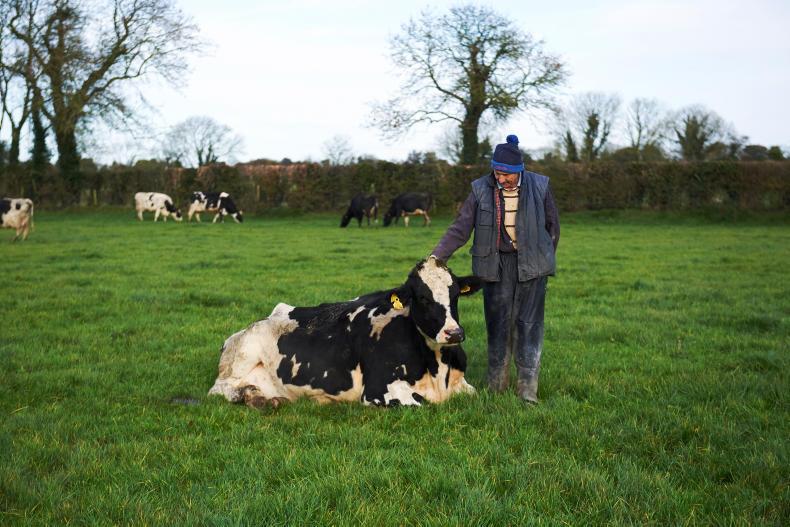
The Farrell herd is now a mix of various cow types. Some of the older, larger Holstein Friesian cows still persist. \ Barry CroninMilk solids
The reason he is picky is that production from the herd is very high. Last year, they produced 490kg of milk solids per cow from 860kg of meal per cow. The year before, they produced 525kg of milk solids/cow from 992kg of meal/cow and this year they are expected to produce 472kg of milk solids from 800kg of meal. What makes the production figures so impressive for this year is that 45% of the herd is first-lactation and 5% of the herd are carry-overs, being empty cows from last year.
Peter reckons the herd will be back to pre-expansion levels of output of 520kg MS to 530kg MS/cow in a few years. This year, with 350 cows to calve, the herd will be stocked at 3.5 cows/ha. On top of this, there will be between 20 and 30 cows that can be carried over. The decision to carry over these cows and increase stocking rate will be governed by milk price, he says.
“The farm can comfortably carry more cows in the summer. The higher stocking rate really means that we will be starting the diet feeder earlier in October,” Peter says.

The Farrells have a 24-unit herringbone parlour. High output
A couple of factors contribute to the high output: obviously the herd is being well fed – lots of good grass and meal and good-quality silage when needed. Lactations are also long. Just because no cows calve in autumn doesn’t that milk isn’t produced over the winter. Cows are milked to 300 days where possible and get about nine weeks dry. Selective dry cow therapy has been practised for the last three years.
The EBI of the herd is only average at €84, with €30 for milk and €27 for fertility. This suggests that the excellent performance is being driven by management, as opposed to excellent genetics. Fertility is reasonably good with 75% of the cows going in calf in the first six weeks of breeding. The empty rate this year is slightly higher than normal with 13% empty after 11 weeks of breeding.
Labour
David and Peter are helped out on the farm by Peter’s brother-in-law Derek Fletcher and Janusz Chlewinski from Poland, a trained veterinary technician who carries out the majority of milkings and cow treatments. The Farrells’ neighbour, Paddy Wright, also helps out on Saturdays and during school holidays. As the farm has grown in size, the jobs being performed by the team have decreased with contractors taking on more of the machinery work. All of the slurry was outsourced last year, while most of the mowing and raking for silage will be outsourced next season. Fertiliser spreading and winter feeding will continue to be done in-house this year.
What is also being contracted out is the rearing of youngstock with a contract-rearing agreement signed with a farmer in Kildare. This will remove a huge amount of the workload and free up the 54ha of outside land for three cuts of silage. Making good-quality silage is something the Farrells don’t compromise on. The silage last winter had a DMD of 79%.
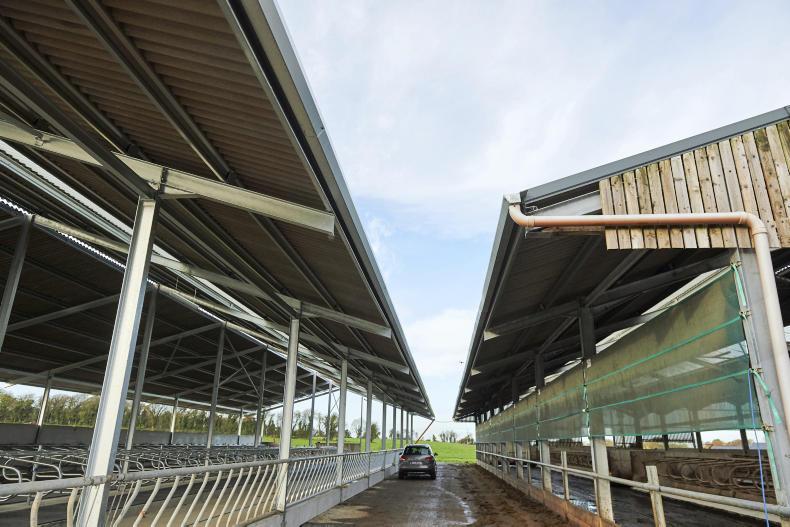
To cater for the extra numbers, significant investment took place last summer. A new shed for 145 cubicles has been built. \ Barry CroninFacilities
To cater for the extra numbers, significant investment took place last summer. A new shed for 145 cubicles was built, an underpass was installed, 40 acres reseeded and the 32ha of leased land fenced and supplied with water. On top of this, 2km of roadways were either installed new or upgraded from being 4m or 5m wide to 6m or 7m wide.
The new cubicle shed is a mirror image of a cubicle shed built in 2012 with distinctive timber cladding on the sides. The new shed has enough slurry storage for only four weeks and cost €850/cubicle. A new slurry store is planned for this year and when completed, it will provide enough slurry storage for the winter and will bring the cost of the shed to €1,000/cubicle.
As for the milking parlour, the Farrells have no plans to upgrade it just yet. Built in 2015, it is a 24-unit DeLaval with ACRs and automatic drafting. It will be milking 16 rows next year but Peter is not overly concerned about it as he says they will take turns milking or milk in shifts.
Due to the nature of the farm, with almost 80% of the land leased, he is reluctant to invest too much more in milking facilities. I asked Peter if the fact they are leasing a lot of their land is a worry for him.
“We’ve been farming rented land all of our lives so it is not a major concern. I suppose the way I see it with a couple of different landowners is that we have all of our eggs in a number of different baskets as opposed to all in one. It’s a slight concern but as long as the business plan says we will make money doing it I’m happy to be where we’re at,” Peter says.
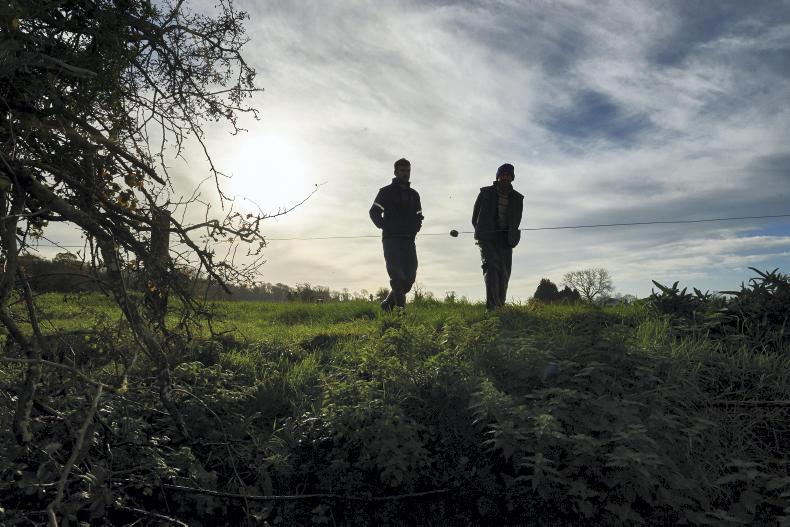
"I love the challenge of dairy farming. Every day is unique and brings with it fresh problems to solve" \ Barry CroninI love the challenge of dairy farming. Every day is unique and brings with it fresh problems to solve.
Gross output
In 2016, the gross output from the farm was €4/kg MS. This figure does not include the Single Farm Payment. Total variable costs amounted to €1.30/kg MS and total fixed costs, including own labour and capital repayments, came to €2.38/kg MS. This left the farm with a profit of €0.32kg MS before the SFP was included.
The remnants of the higher-cost year-round calving days still exist on this farm with plenty of farm machinery around for what is essentially a spring-calving grass farm. However, it’s hard to fault what the Farrells have done. The herd and land area has grown dramatically over the last five years, while debt is back at pre-expansion levels at about €2,000/cow. Even though the overall debt has increased, cow numbers have increased also.
Yet, despite the change in system, a number of factors haven’t changed: good relationships have been maintained, whether that is within the family or with people the Farrells are leasing land from, or with employees. Numerous times throughout the visit, David mentioned the importance of showing respect for land, cows and people. This farm brings out all the best in profitable, grass-based family farming. Is this a path more farms in the northern part of Ireland will follow?
Before leaving, I asked Peter if he ever regrets coming back to farm. His answer said it all.
“I love the challenge of dairy farming. Every day is unique and brings with it fresh problems to solve. I genuinely finish every day looking forward to the next. It’s a great career path regardless of your background.”
Ready more
Long read: Turning a golf course into a dairy farm in Co Kerry
This article first appeared in the Irish Dairy Farmer magazine.
When Peter Farrell qualified as a structural engineer in 2008, the climate for engineers in Ireland was very different to what it was when he enrolled in the course four year previously. Post-economic crash, to get a job as an engineer would have meant emigration. Instead, he chose to work in a different field, that of his parents' farm at Kilmessan, Co Meath.
At the time, his father David was milking 100 cows in a 10-unit parlour supplying milk all-year round to Glanbia. Cows calved for 10 months of the year and the workload was heavy with little time off. Year-round calving to supply liquid milk to the once lucrative Dublin market is the traditional type of dairy farming operated in The Pale – the counties surrounding the capital city.
After doing his Leaving Certificate in 2004, Peter decided to study engineering in university. So why is he farming now?
“I qualified as an engineer in 2008, right at the peak of the economic crash," says Peter. "I lost my first graduate job before I even started. The work I did manage to secure was in a windowless office, monotonous and a 90-minute commute from home. It seemed at the time that emigration was looking like the only option."

Peter qualified as an engineer in 2008 but to get a job in that field he would have had to emigrate, so he went to his parents' field instead. \ Barry CroninChanging fields
“Then one day I was helping my sister, who is an accountant, do the farm accounts for 2008 and when I saw what the farm was capable of turning over, it got me thinking about the opportunities that were on my doorstep. I suppose if I had seen the 2009 turnover I might have come to a different conclusion, but it was too late then,” Peter jokes.
When he was leaving school, farming wasn’t really on the horizon for him, but he knew it was always an option. For Peter and his peers at that time, working in Ireland’s booming construction sector was a bigger lure than working in the dairy industry, as quotas were going to shackle farmers for another 10 years.
I have seen too many good farms destroyed by being held on to too long by the father and the younger person doesn’t get a say or an opportunity to make changes
David says there was never any pressure on any of his children to return home to farm.
“I have seen too many good farms destroyed by being held on to too long by the father and the younger person doesn’t get a say or an opportunity to make changes. I always said that I would retire by 60 and if any of the children wanted it, they could take it on," says David.

"I have seen too many good farms destroyed by being held on to too long by the father and the younger person doesn’t get a say or an opportunity to make changes." \ Barry CroninJoint decisions
David has now passed 60 but is still heavily involved in the day-to-day operation. Strategic decisions are made jointly but are driven by Peter.
And substantial changes have been made. The Farrells have stopped calving cows in the autumn and moved to one spring-calving block. This was a big change for David, having been calving cows in the autumn since he started farming in 1950. He says year-round calving always put food on the table, but as Peter pointed out, there are now more mouths to feed.
Back in 2009, the Farrells were farming 72ha in total with 32ha in the milking block. They were milking 100 cows and rearing all progeny. The replacement heifers were calving at 30 months of age and the male calves were kept for bull beef.
In 2010, they started to focus more on breeding by using high EBI sires; they started measuring grass and financial budgeting. In 2011, they moved to calving the heifers at 24 months of age and moved to two 12-week breeding periods. This, along with quota restrictions, allowed a major cull of infertile and carry-over cows. They also leased a 24-hectare outfarm.
In 2012, they reduced the autumn calving period to six weeks, which was sufficient to fill the liquid milk contract for December and January and meant that this contract was not being diluted with extra litres. A new cubicle shed for 110 cows was built that year also, along with additional roadways and 18ha was reseeded.

The Farrells have cut out autumn calving. \ Barry CroninIncreasing numbers
In 2013, cow numbers increased to 120 and 9ha was purchased on the milking platform. An additional 14ha was also reseeded that year. In 2014, cow numbers increased to 135. Extra milk quota was purchased and a new 24-unit milking parlour was built, along with extra slurry storage and a further 18ha was reseeded.
Since quotas went, more land has been leased and cow numbers have increased with 200 milked in 2016. An extra 33ha was leased at the beginning of 2017, bringing land on the milking platform to 100ha.
The lease for the new land was signed in February 2017. Originally, the Farrells had intended to milk 230 cows that year. But with the new land on stream, extra animals had to be purchased if the farm was to be stocked correctly, so they bought 54 calved heifers in March. Peak cow numbers milked in 2017 were 290.
No more autumn calving
While the number of cows being milked has trebled, the system they are being milked in has changed also, with autumn calving having ceased. The whole herd now calves in an 11-week period in spring.
Peter places a big emphasis on grass and this is paying off. Grass growth has averaged 16t/ha over the last three years, with 80% of the farm growing in excess of 16.5t/ha in 2016. This year, Peter reckons the farm will finish up having grown 17t/ha of grass.
He says the fertiliser bill is now bigger than the meal bill, with as much chemical nitrogen and phosphorus spread as is permitted, along with lime and potash where required. All of the owned land and most of the leased land is now at index 3 and 4, but a lot of the most recently acquired land has very low soil fertility.

Good management is the key to profitability on this farm. \ Barry CroninSoil fertility
“The soil fertility on this block was on the floor, but because it was all in new grass this year, and because it was well fertilised, grass exploded all year,” Peter says.
Over half of the milking platform has been reseeded over the past two years so a very high proportion of the farm has good grass species. This is undoubtedly helping the farm to achieve such high grass growth rates. The farm grew over 4kg/day last winter.
But the farm is also well fertilised. Most of the milking block receives a maintenance fertiliser rate of four to five bags/acre of 18:6:12 spread over three applications. The silage fields and lower soil fertility fields are targeted most with slurry. So the maintenance is provided by chemical fertiliser and the build-up is provided by slurry.
Cow type
The Farrell herd is now a mix of various cow types. Some of the older, larger Holstein Friesian cows still persist; many of their offspring are also on the large side.
Over the last few years, the emphasis has been on using high-EBI Holstein Friesian sires on the cows. Last year, all the heifers calved down to Jersey and nearly all the cows were put in calf to Jersey.
“It’s not a big deal,” says Peter. “The first cross heifer is a super animal so for me it’s a no-brainer to use Jersey and as herd size grows we need an easier-care cow. I think our cows are an ideal cross for Jersey as they have plenty of milk from the liquid milk days.”
His plan is to have a herd of 75% Holstein Friesian cows and 25% Jersey cows, or an F12 J4 in genetic terms. To get this, he intends using a high-EBI Holstein Friesian bull on his 50:50 crossbred cows and a crossbred bull on these to maintain the ratio of breeds as much as possible.
Of the 54 bought-in heifers, 25 were Jersey crossbred, five were purebred Jersey (as a novelty) and the rest were high EBI. Peter says he tried to source more crossbreds but was unable to find the animals he wanted. Interestingly, he turned down buying some high-EBI crossbred heifers as he felt the average production from their herd would be too low, even at 450kg MS/cow, on average.

The Farrell herd is now a mix of various cow types. Some of the older, larger Holstein Friesian cows still persist. \ Barry CroninMilk solids
The reason he is picky is that production from the herd is very high. Last year, they produced 490kg of milk solids per cow from 860kg of meal per cow. The year before, they produced 525kg of milk solids/cow from 992kg of meal/cow and this year they are expected to produce 472kg of milk solids from 800kg of meal. What makes the production figures so impressive for this year is that 45% of the herd is first-lactation and 5% of the herd are carry-overs, being empty cows from last year.
Peter reckons the herd will be back to pre-expansion levels of output of 520kg MS to 530kg MS/cow in a few years. This year, with 350 cows to calve, the herd will be stocked at 3.5 cows/ha. On top of this, there will be between 20 and 30 cows that can be carried over. The decision to carry over these cows and increase stocking rate will be governed by milk price, he says.
“The farm can comfortably carry more cows in the summer. The higher stocking rate really means that we will be starting the diet feeder earlier in October,” Peter says.

The Farrells have a 24-unit herringbone parlour. High output
A couple of factors contribute to the high output: obviously the herd is being well fed – lots of good grass and meal and good-quality silage when needed. Lactations are also long. Just because no cows calve in autumn doesn’t that milk isn’t produced over the winter. Cows are milked to 300 days where possible and get about nine weeks dry. Selective dry cow therapy has been practised for the last three years.
The EBI of the herd is only average at €84, with €30 for milk and €27 for fertility. This suggests that the excellent performance is being driven by management, as opposed to excellent genetics. Fertility is reasonably good with 75% of the cows going in calf in the first six weeks of breeding. The empty rate this year is slightly higher than normal with 13% empty after 11 weeks of breeding.
Labour
David and Peter are helped out on the farm by Peter’s brother-in-law Derek Fletcher and Janusz Chlewinski from Poland, a trained veterinary technician who carries out the majority of milkings and cow treatments. The Farrells’ neighbour, Paddy Wright, also helps out on Saturdays and during school holidays. As the farm has grown in size, the jobs being performed by the team have decreased with contractors taking on more of the machinery work. All of the slurry was outsourced last year, while most of the mowing and raking for silage will be outsourced next season. Fertiliser spreading and winter feeding will continue to be done in-house this year.
What is also being contracted out is the rearing of youngstock with a contract-rearing agreement signed with a farmer in Kildare. This will remove a huge amount of the workload and free up the 54ha of outside land for three cuts of silage. Making good-quality silage is something the Farrells don’t compromise on. The silage last winter had a DMD of 79%.

To cater for the extra numbers, significant investment took place last summer. A new shed for 145 cubicles has been built. \ Barry CroninFacilities
To cater for the extra numbers, significant investment took place last summer. A new shed for 145 cubicles was built, an underpass was installed, 40 acres reseeded and the 32ha of leased land fenced and supplied with water. On top of this, 2km of roadways were either installed new or upgraded from being 4m or 5m wide to 6m or 7m wide.
The new cubicle shed is a mirror image of a cubicle shed built in 2012 with distinctive timber cladding on the sides. The new shed has enough slurry storage for only four weeks and cost €850/cubicle. A new slurry store is planned for this year and when completed, it will provide enough slurry storage for the winter and will bring the cost of the shed to €1,000/cubicle.
As for the milking parlour, the Farrells have no plans to upgrade it just yet. Built in 2015, it is a 24-unit DeLaval with ACRs and automatic drafting. It will be milking 16 rows next year but Peter is not overly concerned about it as he says they will take turns milking or milk in shifts.
Due to the nature of the farm, with almost 80% of the land leased, he is reluctant to invest too much more in milking facilities. I asked Peter if the fact they are leasing a lot of their land is a worry for him.
“We’ve been farming rented land all of our lives so it is not a major concern. I suppose the way I see it with a couple of different landowners is that we have all of our eggs in a number of different baskets as opposed to all in one. It’s a slight concern but as long as the business plan says we will make money doing it I’m happy to be where we’re at,” Peter says.

"I love the challenge of dairy farming. Every day is unique and brings with it fresh problems to solve" \ Barry CroninI love the challenge of dairy farming. Every day is unique and brings with it fresh problems to solve.
Gross output
In 2016, the gross output from the farm was €4/kg MS. This figure does not include the Single Farm Payment. Total variable costs amounted to €1.30/kg MS and total fixed costs, including own labour and capital repayments, came to €2.38/kg MS. This left the farm with a profit of €0.32kg MS before the SFP was included.
The remnants of the higher-cost year-round calving days still exist on this farm with plenty of farm machinery around for what is essentially a spring-calving grass farm. However, it’s hard to fault what the Farrells have done. The herd and land area has grown dramatically over the last five years, while debt is back at pre-expansion levels at about €2,000/cow. Even though the overall debt has increased, cow numbers have increased also.
Yet, despite the change in system, a number of factors haven’t changed: good relationships have been maintained, whether that is within the family or with people the Farrells are leasing land from, or with employees. Numerous times throughout the visit, David mentioned the importance of showing respect for land, cows and people. This farm brings out all the best in profitable, grass-based family farming. Is this a path more farms in the northern part of Ireland will follow?
Before leaving, I asked Peter if he ever regrets coming back to farm. His answer said it all.
“I love the challenge of dairy farming. Every day is unique and brings with it fresh problems to solve. I genuinely finish every day looking forward to the next. It’s a great career path regardless of your background.”
Ready more
Long read: Turning a golf course into a dairy farm in Co Kerry
This article first appeared in the Irish Dairy Farmer magazine. 













 This is a subscriber-only article
This is a subscriber-only article

















SHARING OPTIONS: